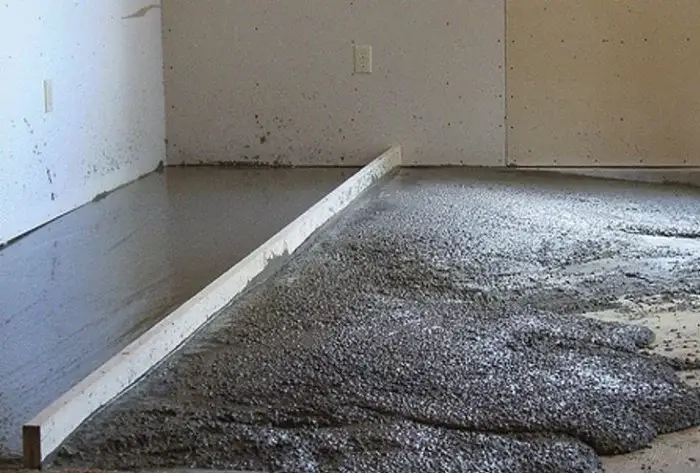The floor screed is carried out in order to level the base for the subsequent laying of the floor covering. Depending on the further work and the quality of the resulting surface, then you can immediately lay the floor covering, for example, tiles on it. More demanding coatings may require additional leveling with a self-levelling compound. You can find out prices for floor screed repair. The arrangement of a cement-sand floor screed is necessary when the differences reach a level of 2 cm or more (in modern new buildings it can be 5-10 cm), it is also required when arranging an electric or water heated floor.
Works are executed in the following sequence:
1. Installation of beacons
For this, special metal products are used, which are called beacons. Instead, you can use other even metal structures, for example, drywall profiles, but this is already a artisanal approach and is used when the building materials are left over from previous work.
Beacons are lined up parallel to each other with a distance from 50 cm to 1.2 m, depends on how it is more convenient for the master to work. It is necessary to put them at such a distance that it is possible to level the cement mortar over the beacons as a rule.
In order to set the beacons at the same level on the floor, wooden or concrete supports are placed under them, you can use those screwed to the desired depth self-tapping screws, etc. The main thing is to put them all in one flat plane, which after pouring will provide a smooth floor. Lighthouses are usually fixed with a mortar for laying tiles, you can use starting plaster.
2. Preparing the base
Preparing the base before pouring, if waterproofing was not laid, comes down to cleaning the working surface. The floor must be swept or vacuumed to remove possible dust and sand. After that, the surface is abundantly primed with a deep penetration solution using a brush or roller. It is desirable to carry out the primer at least 2 times. If the waterproofing layer already lies, then they simply remove dust and sand.
All work is done very carefully so as not to knock down already installed beacons. If the beacon was accidentally hit, it must be reinstalled.
3. Filling
It is necessary to perform the following steps:
- Prepare a mortar at the rate of sand and cement 3:1. You can add more cement, the main thing is not to overdo it with sand, otherwise the screed will crumble. It is also recommended to add some surfactants to improve adhesion. For screed, you can use ready-made mixtures with all additives, or make them using special building materials. At home, 50 ml of liquid soap per 8-10 liters of solution are added as surfactants.
- The solution should have a viscous liquid state, then it is convenient to pour and level it. There should not be any lumps.
- Everyone chooses for himself how much solution it is convenient for him to work with, the main thing is to have time to smooth it over the surface until the mixture begins to harden.
The pouring process does not cause special difficulties, the whole point is to properly prepare the solution and level it on the surface with the rule, guided by the beacons. If you decide to start such work on your own, then think over in advance the ways to retreat. A properly prepared solution will harden in a day, and an improperly prepared one - in 2-3 days. After the screed has hardened, it is recommended to prime it again at least twice.
An important point: when pouring a cement-sand screed, further work on laying the flooring can be carried out at least a week later for tiles, and after a month for laminate , parquet, parquet board or linoleum.





